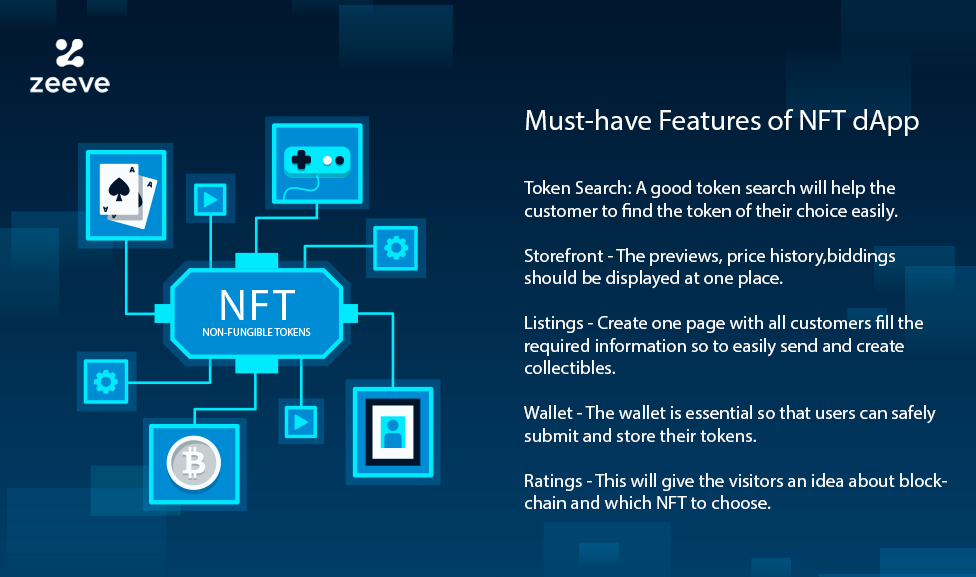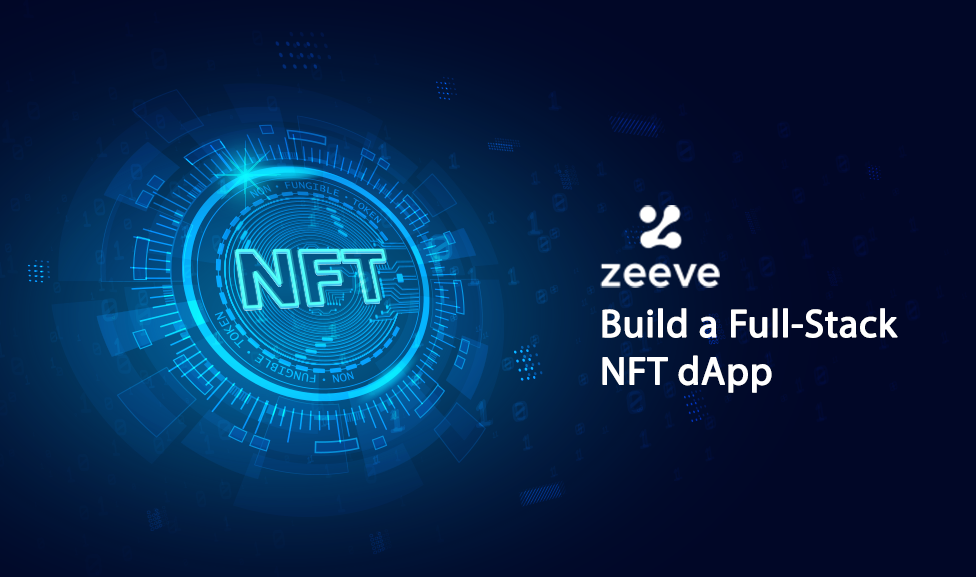Blockchain has a pivotal application called NFT. Integrating NFTs with businesses has opened realms of innovation and massive revenue. It is a new way to commercialize your brand and transform digital work into a tradable digital asset. These digital assets are the best way to attract tech-savvy clients.
Authenticity has always been challenging in fintech, e-commerce, and other enterprises and NFTs are a way to bring originality. Non-fungible tokens (NFTs) let you tokenize, i.e. sell digital work such as art, games, collectibles, music, and many more. It has given a different edge to marketing and new revenue streams.
In this blog, we will understand about the popularity of Non-Fungible Tokens, and the importance of an NFT marketplace. What is NFT dApp? Benefits related to NFT dApp and deploying a full-stack NFT dApp on Ethereum.
The Popularity of Non-Fungible Tokens
In 2022 NFT has a market valuation of $828 million. The numbers are enough to tell about its importance. Each NFT is different; the reason lies in the fact that every NFT has a different identification code. The NFT is being exchanged or traded at equivalent units. Similar to the buying and selling of a painting. More and more businesses are coming forward to incorporate NFT in their branding strategy, the reason being:
- Authenticity: The immutability feature on the blockchain is why anyone on the blockchain network cannot modify or replace the NFT. Individuals’ can secure their identities.
- Non-interoperability: Every NFT is unique and this makes it difficult to exchange with any other crypto.
- Tradable: The NFTs are upgraded with smart contracts; thus, anyone purchasing the NFT can further resell it.
- Liquidity: The tokens are available at various crypto exchanges; this improves the tradability of NFT and also increases the liquidity in the market.
- Proof of Ownership: The ownership of the NFT connects with a single account. Even if someone takes a picture of NFT, that doesn’t make them the owner. The real ownership remains to the one who created it.
Importance of NFT marketplace
Regarding businesses and brands, NFT is helping the brands in market expansion. Brands such as Nike, Taco Bell, and Dolce & Gabanna are a few examples. For instance, Taco Bell has developed its NFTs by suggesting digital items. Similarly, to celebrate International Friendship day on Jul 30th, Coca-Cola released NFTs.
This is how the future of digital marketing will look for enterprises. The buying and selling of all collectibles will occur in the digital space. The marketplace will also be authentic, as a person cannot make transactions without a user account. The NFT marketplaces can be used as auction platforms or regular stores.
What is dApp?
dApp or decentralized application is a software application that runs on the blockchain network. You can consider it very similar to mobile applications. The difference here is that it is not controlled by one organization. Suppose for Youtube there is Youtube headquarters in America that handles Youtube. However, dApps are entirely decentralized and work on a peer-to-peer network.
The two very basic steps in app development or website development are frontend and backend. While the frontend is where all the user interacts with — the text on apps, color, buttons, etc.
The backend is on the server-side of an app or website where there is — the arrangement of data, storage of data. Basically, the area that the website or app owners handle.
And a full-stack developer is the one who develops both the frontend and backend.
The reason for the decentralization of dApps is that in a dApp smart contracts are at the backend. Smart contracts are coded on the app. These contracts are executed on their own when terms and conditions are met. The smart contracts are hosted on multiple computer nodes all across the world.
Regarding the frontend of dApps, it is written in any programming language such as C, C++, Java, etc. For instance, in the case of Ethereum, “Solidity” is the language.
What is NFT dApp?
NFT dApp is a combination of a decentralized platform that offers a marketplace for NFT. For example, Axie Infinity dApp is a game with a market valuation of $3 billion.
The dApp is like a marketplace for NFTs where minting, selling, and buying of NFTs is being done.
The way to sell the NFT is through existing platforms such as Ripple, Open Sea, etc, or one can try to create their very own marketplace. To create a marketplace, the basic requirement is smart contract functionality. Once the testing and deploying of the smart contract on the blockchain are done.
Further, there is deploying of metadata endpoint. The deploying is essential for tokens, and this translates each token’s identifier. The identifier traces to the reference of the NFT asset itself. To make your users buy, shop, mint, or even view NFTs, then you would require a dApp also called NFT dApp.
Launching a Non-Fungible Tokens dApp Marketplace
Having your own NFT dApp requires deciding on few of the factors such as — your potential customers, challenges that your platform might face, or the kind of NFTs your business will promote. Before entering the market, study vertical and horizontal markets. While the vertical one focuses on a specific type of customer, the horizontal market such as eBay focuses on a large group of customers.
Take your time in project documentation so that when hiring a blockchain service provider, there will be clear communication between both groups. Hire an NFT dApp developer for the creation of a marketplace. This will cut your extra expenses and save time.
To build the NFT dApp pass the internal logic of the smart contracts generator into a decentralized part. Do a thorough software check before deploying the dApp on the mainnet.
Benefits of NFT dApp
dApps require tokens such as — trade tokens, game tokens, stakes, etc to use the features of the apps. Very similar to how mobile apps or websites charge for their subscriptions. The technology has multiple benefits to offer. Let’s understand a few of them:
- There is no single entity controlling the dApp, neither any government nor any organization. So, artists or institutions can freely share their work.
- There is no hosting server, unlike other apps. Thus, there isn’t a single point of failure.
- Being open-source, it is a faster and more secure technology.

Basic steps to “build a full-stack NFT dApp”
There are many platforms for creating NFTs among which Ethereum is the most popular one. So we will discuss the NFT dApp building on Ethereum.
The first and the foremost step is to make an NFT which can be done by publishing a smart contract on the ERC-721 or ERC-1155. 721 has a single token standard; so you can transfer one token at a time. ERC-1155 is used for the multi-token standard with batch functionality. Here are the eight steps to building a full-stack NFT dApp.
- Step 1: Clone the starter files: To understand the cloning of files, you can follow the guide on GitHub.
- Step 2: Check out our starter files, by running react projects in the browser.
- Step 3: Setting up the Ethereum wallet is one of the basic steps. As the network provides smart contract functionality. The Metamask account is essential for transactions on Ethereum.
- Step 4: After the Metamask wallet is set up, connect the dApp to it.
- Step 5: Configure the NFT Metadata and store it to later pass it in as the tokenURI parameter.
- Step 6: Sign up on Pinata as it’s a requirement to pin your metadata to the IPFS function.
- Step 7: Upload the NFT metadata to the smart contract so we can mint the NFT.
- Connect mintNFT to our Minter.js frontend and deploy NFT to a live website
If you are willing to understand in-depth about the programming. Check out this tutorial here.
Wrapping Up
NFT dApps are an inventive approach and will be profitable for businesses and individuals. However, the dApps can be deployed by proper planning and execution. The NFT trend is here to stay and will benefit investors, enterprises, and developers on a rapid scale. With more and more participation, the unregulated marketplace will also become manageable in the future.
Every organization will have to understand that a certain amount of research and tech architecture requires time. Thus collaborating with professionals will make the job easier and will help them save time and money.
Partner with Zeeve
Zeeve is the leading blockchain infrastructure management platform. We help enterprises and Blockchain startups to build, deploy and manage their decentralized applications(dApps). Our platform is cloud-agnostic and supports multiple Blockchain protocols with advanced analytics and monitoring of nodes and networks.
We feature a robust set of APIs to build DApps for a plethora of use cases across industries, including asset tokenization, NFTs, DEX, Stablecoins, etc. Zeeve supports Decentralized Finance (DeFi) space with decentralized storage, trusted nodes, and smart contracts. Let’s connect to start your NFT dApp project with the help of our experts.
To learn more about Zeeve, join us on Twitter and Telegram.






















